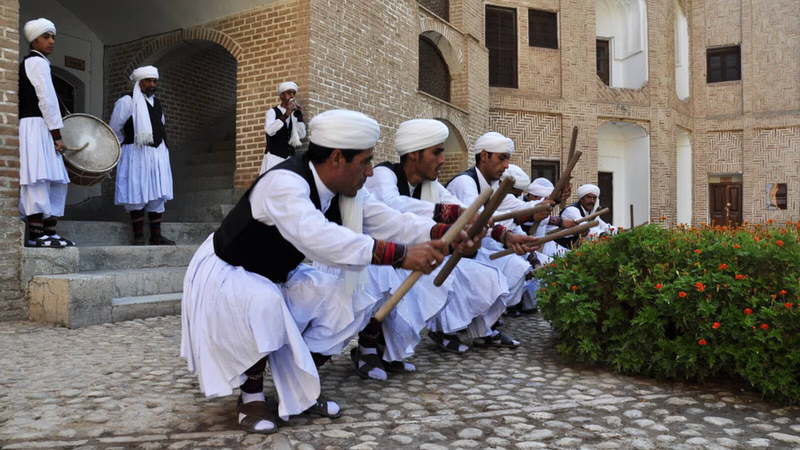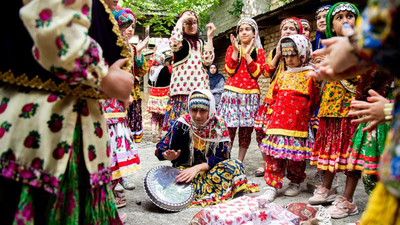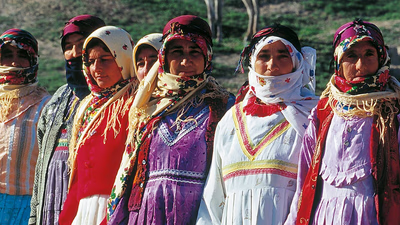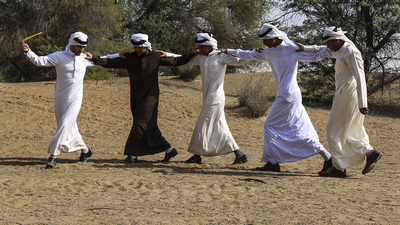
Traditional hand-embroidered clothes showcase cultural heritage.
In the Middle East, traditional hand-embroidered clothing can be found in countries such as Iran, Iraq, Turkey, Syria and Lebanon . In Iran, for example, traditional clothes such as chadors, skirts, scarves and highway hats are sewn colorfully and in various designs. Also, traditional Arabic hand-embroidered clothes are also famous in Persian Gulf countries such as Saudi Arabia, Oman, Qatar and the United Arab Emirates . These clothes, including Abba, Shameez, and Arabic shawls, include various patterns and designs, which are often decorated using hand embroidery and knitting stitches. In West Asia, traditional hand-embroidered clothes can be seen in countries such as Afghanistan, Pakistan . In these areas, traditional clothes such as back pants, sarees, long shawls and men's clothes such as kirtas and pajamas are hand-stitched. The designs and patterns used in these clothes also vary based on the culture and region concerned.
Cotton is one of the most famous materials used in traditional clothing. These natural fibers are obtained from the cotton plant and are used to produce soft and breathable fabrics. Silk is one of the most luxurious and famous materials used in traditional clothing. This soft and shiny fiber is obtained from silkworms and is used to make office and formal clothes. Linen is a textile material obtained from the flax plant. These fibers are resistant and cool and are used to produce traditional clothing in tropical regions. Wool is obtained from the skin of sheep and other woolly animals. This fiber is soft and warm and is used to make winter clothes and traditional clothes in cold regions. In some traditional clothing, animal skins such as leather or animal wool are used. This type of material is used to make traditional men's clothing and traditional clothes such as suits.
Traditional hand-embroidered clothes in Middle East and West Asian countries are known as part of the culture and identity of the people of these regions. These garments are often produced using traditional weaving machines, such as knitting and hand embroidery, and include various designs and motifs that are related to the history, ethnicity, and region in question. Since each country and region has its own history and culture, the traditional hand-embroidered clothes of these regions are important symbols of the identity and culture of their people. These clothes are also considered as a handicraft and industrial art and are attractive to tourists and those interested in local cultures.
- Chador or traditional mantle is used in Iran and some Middle Eastern countries, such as Iraq and Oman. These clothes are generally made of soft and colorful fabrics and are decorated with various designs and patterns.
- Arabic dress or Abba is a traditional dress in Arab countries such as Saudi Arabia, Qatar and the United Arab Emirates. Abba is a long covering that is placed over inner clothes and is often made in dark and classic colors. In some regions, the robe is decorated with beautiful hand embroidery and embroidery.
- It is a traditional Taji hat that is used in Iran and some Middle Eastern countries. These hats are often made of soft and beautiful fabrics and decorated with hand embroidery and embroidery.
- Traditional shawls are considered as one of the popular clothes in the Middle East. Shawls are usually made of soft and colorful fabrics and decorated with various patterns and designs. These shawls can be hand sewn or woven.
- In some Middle Eastern countries, such as Iraq and Oman, there is also traditional men's clothing. This clothing includes shirts, pants, vests and neckerchiefs, which are decorated using hand embroidery and various decorations.
Traditional hand-embroidered clothes have many artistic and handicraft values. These clothes not only represent the culture and identity of the people of the region, but are also symbols of handicraft and industrial art. The production of traditional hand-stitched clothing usually requires special skills that are passed down from generation to generation. These garments are woven and sewn by hand and are often produced using traditional tools and natural raw materials. Skilled tailors create beautiful designs and detailed decorations on fabrics using special techniques.
Types of sewing and hand embroidery used in traditional clothing include embroidery, embroidery, jewel embroidery, cashmere, needlework and other similar techniques. These handicraft techniques and decorations related to traditional clothing require high artistic and industrial skills and require patience, precision and technical knowledge. In addition, traditional hand-stitched clothes have economic value as well. These handicrafts can help generate income and employment in local communities and contribute to economic development and local trade.
Traditional hand-embroidered clothes in the Middle East are still used in people's daily lives. These clothes not only have the aspects of handicrafts and works of art, but are also used as traditional and popular clothing in some regions and societies of the Middle East. Many people in the Middle East still wear traditional clothing in religious ceremonies, family events, celebrations and special occasions. For example, in Iran, women usually choose the traditional chador wedding dress in some special events and ceremonies such as weddings, engagements and religious celebrations. Also, men can wear Arabic clothes or other traditional clothes in official and special ceremonies. In addition to special ceremonies, some traditional clothes are still protected in the daily life of some people in the Middle East. For example, in some rural areas, women use traditional shawls and handkerchiefs as part of their everyday clothing. Also, in some Arab countries, men still use Arabic clothes as their formal and everyday clothes.



